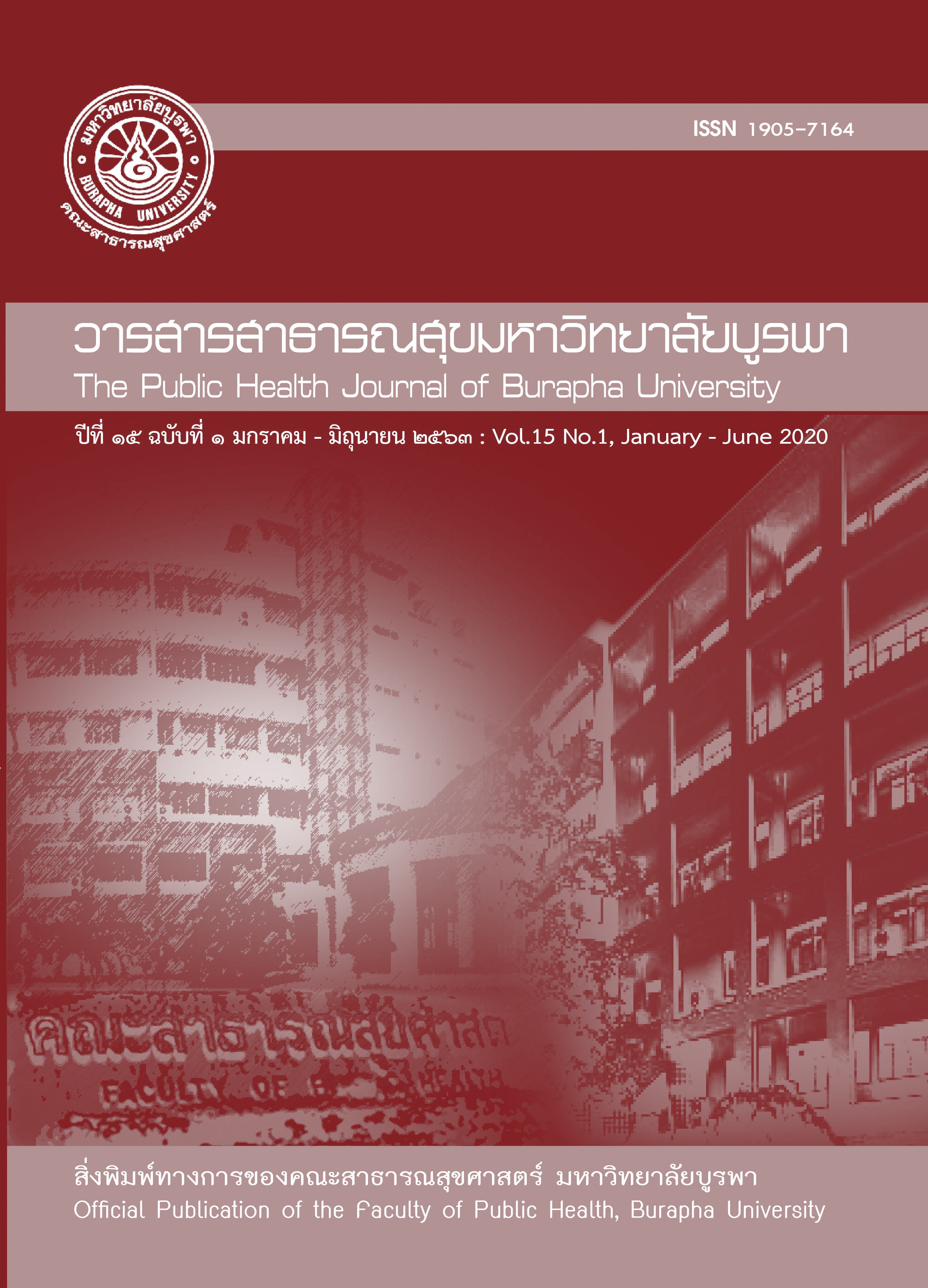การเปรียบเทียบภาวะเท้าแบนและเท้าปกติในการทรงท่าแบบอยู่นิ่งและเคลื่อนไหว
Main Article Content
บทคัดย่อ
A Comparison of Pronated and Normal Foot Postures on Static and Dynamic Postural Stability
การเคลื่อนไหวที่มากเกินไปของข้อต่อบริเวณเท้า และการเปลี่ยนแปลงตำแน่งการลงน้ำหนักในภาวะเท้าแบนอาจส่งผลต่อการควบคุมการทรงท่า โดยเฉพาะในขณะยืนขาเดียวบนเท้าแบนขณะทำกิจกรรม ดังนั้น การศึกษานี้จึงเปรียบเทียบการทรงท่าแบบอยู่นิ่งโดยยืนทรงท่าบนขาข้างเดียวร่วมกับปิดตา และขณะทดสอบทรงท่าแบบเคลื่อนไหวโดยใช้การทดสอบ star excursion balance ระหว่างผู้ที่มีภาวะเท้าแบนและเท้าปกติ ผู้เข้าร่วมวิจัยจะถูกจัดอยู่ในกลุ่มเท้าแบน (20 คน) และเท้าปกติ (20 คน) จากการวัดความสูงของกระดูกนาวิคูล่าบนขาข้างถนัด และประเมินระยะทางที่สามารถยื่นขาไปได้ไกลที่สุดในการทดสอบ star excursion balance ทั้ง 8 ทิศทาง และประเมินจุดศูนย์กลางแรงกดที่ฝ่าเท้าโดยใช้เครื่อง footscan system ขณะทดสอบการทรงท่าแบบอยู่นิ่งและเคลื่อนไหว ผลงานวิจัยพบว่าข้อมูลการเคลื่อนที่ของจุดศูนย์กลางแรงกดขณะทรงท่าแบบอยู่นิ่ง และระยะทางขณะทดสอบการทรงท่าแบบเคลื่อนไหวไม่มีความแตกต่างระหว่างทั้ง 2 กลุ่ม (p > 0.05) อย่างไรก็ตาม กลุ่มเท้าแบนมีค่าระยะทางการเคลื่อนที่ไกลที่สุด และพื้นที่การแกว่งของจุดศูนย์กลางแรงกด ขณะทดสอบการทรงท่าแบบเคลื่อนไหวในทิศทางด้านใน และด้านหลังเยื้องด้านในมากกว่ากลุ่มเท้าปกติ (p < 0.05) ผลงานวิจัยนี้ยืนยันว่า การทดสอบการทรงท่าแบบอยู่นิ่งอาจไม่เพียงพอที่จะประเมินความแตกต่างในการทรงท่าระหว่างผู้ที่มีภาวะเท้าแบนและเท้าปกติ อย่างไรก็ตาม ผู้ที่มีภาวะเท้าแบนมีความยืดหยุ่นของเท้ามากกว่าปกติ และมีการปรับตัวของเท้าขณะทรงท่า ดังนั้นในทางคลินิกจึงควรพิจารณาประเมินการทรงท่าขณะเคลื่อนไหวซึ่งอาจส่งผลต่อปัญหาจากภาวะเท้าแบน
Joints hypermobility and changes in surface contact area in the pronated foot may affect postural control especially in unilateral stance over the pronated foot during functional activities. Thus, this study compared the static single limb stance with an eyes-closed condition (SLS) and the dynamic postural stability (star excursion balance test: SEBT) between pronated and normal foot postures. The participants were classified as a pronated foot (n=20) and normal foot (n=20) based on the navicular drop test on dominance leg. They were evaluated maximum reach distance during SEBT in 8 directions. We measured the center of pressure by the footscan system during SLS and SEBT. The results showed that the center of pressure during SLS and maximum reach distance during SEBT were not significantly different between both groups (p > 0.05). However, the pronated foot group had a significantly greater maximum distance and the sway area of the center of pressure during SEBT in medial and posteromedial directions than normal foot group (p < 0.05). These results confirmed that the static postural stability test may not be adequate to assess the difference between pronated and normal foot. However, the pronated foot persons had greater flexibility and adaptability of the foot. Therefore, the clinician should consider evaluating the dynamic postural stability which may affect the pronated foot problems.
Article Details
เอกสารอ้างอิง
2. Buchanan KR, Davis I. The relationship between forefoot, midfoot, and rearfoot static alignment in pain-free individuals. J Orthop Sports Phys Ther, 2005; 35(9): 559-66.
3. Cobb SC, Tis LL, Johnson BF, Higbie EJ. The effect of forefoot varus on postural stability. J Orthop Sports Phys Ther, 2004; 34(2): 79-85.
4. Pohl MB, Hamill J, Davis IS: Biomechanical and anatomic factors associated with a history of plantar fasciitis in female runners. Clin J Sport Med, 2009; 19: 372–6.
5. Neal BS, Griffiths IB, Dowling GJ, Murley GS, Munteanu SE, Franettovich Smith MM, et al. Foot posture as a risk factor for lower limb overuse injury: a systematic review and meta-analysis. J Foot Ankle Res, 2014; 7: 55.
6. Carvalho CE1, da Silva RA, Gil AW, Oliveira MR, Nascimento JA, Pires-Oliveira DA. Relationship between foot posture measurements and force platform parameters during two balance tasks in older and younger subjects. J Phys Ther Sci, 2015; 27(3): 705-10.
7. Palmieri RM, Ingersoll CD, Stone MB, Krause BA. Center-of-pressure parameters used in the assessment of postural control. J Sport Rehabil, 2002; 11: 51–66.
8. Hertel J, Gay MR, Denegar CR. Differences in postural control during single-leg stance among healthy individuals with different foot types. J Athl Train, 2002; 37: 129–32.
9. Perez-Cruzado D, González-Sánchez M, Cuesta-Vargas AI. Parameterization and reliability of single-leg balance test assessed with inertial sensors in stroke survivors: a cross-sectional study. Biomed Eng Online, 2014; 13(1): 127.
10. Tsai LC, Yu B, Mercer VS, Gross MT. Comparison of different structural foot types for measures of standing postural control. J Orthop Sports Phys Ther, 2006; 36(12): 942–53.
11. Cote KP, Brunet ME, Gansneder BM, Shultz SJ. Effects of pronated and supinated foot postures on static and dynamic postural stability. J Athl Train, 2005; 40(1): 41-6.
12. Gribble PA, Hertel J, Plisky P. Using the star excursion balance test to assess dynamic postural-control deficits and outcomes in lower extremity injury: a literature and systematic review. J Ath Train, 2012; 24(3):339-57.
13. Hertel J, Miller SJ, Denegar CR. Intratester and intertester reliability during the star excursion balance tests. J Sport Rehabil, 2000; 9(2): 104-16.
14. Gribble PA, Hertel J. Considerations for normalizing measures of the star excursion balance test. Meas Phys Ed Exerc Science, 2003; 7(2): 89-100.
15. Razeghi M, Batt ME. Foot type classification: a critical review of current methods. Gait Posture, 2002; 15(3): 282-91.
16. Eluwa M, Omini R, Kpela T, Ekanem T, Akpantah A. The incidence of pes planus amongst Akwa Ibom State students in the University of Calabar. Internet J Forensic Sci, 2009; 3(2): 1-5.
17. Chen G, Liu L, Yu J. A comparative study on strength between American College male and female students in Caucasian and Asian populations. Sport Science Review, 2012; 21(3-4): 153-65.
18. Cuğ M, Özdemir RA, Ak E. Influence of leg dominance on single-leg stance performance during dynamic conditions: An investigation into the validity of symmetry hypothesis for dynamic postural control in healthy individuals. Turk J Phys Med Rehab, 2014; 60(1): 22-6.
19. Farenc I, Rougier P, Berger L. The influence of gender and body characteristics on upright stance. Ann Hum Biol, 2003; 30(3): 279-94.
20. Plisky PJ, Rauh MJ, Kaminski TW, Underwood FB. Star excursion balance test as a predictor of lower extremity injury in high school basketball players. J Orthop Sports Phys Ther, 2006; 36(12): 911–9.
21. Huang TH, Chou LW, Huang CY, Wei SW, Tsai YJ, Chen YJ. H-reflex in abductor hallucis and postural performance between flexible flatfoot and normal foot. Phys Ther Sport, 2019; 37: 27-33.

